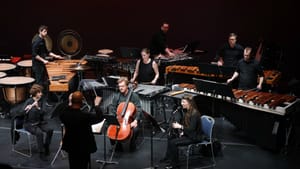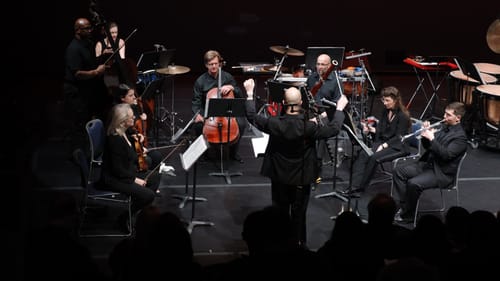Stay in the Loop
BSR publishes on a weekly schedule, with an email newsletter every Wednesday and Thursday morning. There’s no paywall, and subscribing is always free.
Celebrating Mexican music
Orchestra 2001 and Esperanza present ‘¡Conexiones!’

Many of the most exciting developments in the classical music world in recent decades hail from Latin America, from Venezuela’s El Sistema to Paraguay’s Orquestra de Instrumentos Reciclados de Cateura and Bolivia’s Orquesta Experimental de Instrumentos Nativos. Yet within most traditional classical music organizations, including those specializing in contemporary music, it is still relatively uncommon to hear music by Latin American composers. So I was excited about ¡Conexiones!, a partnership between Orchestra 2001 and North Philadelphia’s Esperanza, in its new Teatro Esperanza space.
Looking for Latinx composers
I was also curious about how the organizers would approach the risk that programming these Mexican composers only for a concert on May 5 at a Latinx social services agency might tokenize these artists. Because Orchestra 2001 has—like many of its peers—programmed relatively little music by Latinx composers otherwise, it’s worth asking. (I worked briefly with Orchestra 2001 executive director Adam Lesnick when we both participated in Temple Contemporary’s 2017 Symphony for a Broken Orchestra project.)
Based on a scan of past Orchestra 2001 programs available on their website, it is likely—though not certain, as I can’t presume the ethnicities of composers who do not publicly state them—that the ensemble’s most recent prior programming of a Latinx composer was more than three years ago: a piece by Carlos Sanchez Gutiérez in March 2016. Meanwhile, the Philadelphia Orchestra featured a concert titled South American Sounds last fall, but the program opened with Gershwin’s Cuban Overture, a captivating piece but a geographical miss based on both composer and subject.
At the May 5 concert, all four ¡Conexiones! pieces had unusual instrumentations that allowed for fascinating blends of timbres. If 20th-century American music ensembles had looked toward Mexico as they had looked toward Europe, one wonders whether piccolo, flute, clarinet, trombone, and percussion might have become a standard in New Music today, versus the dominant Euro-centric Pierrot ensemble (flute, clarinet, violin, cello, piano).
Chávez and Revuelta
In Carlos Chávez’s 1940 Xochipilli, which opened the program with the Mexican-style instrumentation, inspiration came from an “imaginary musical folklore”—what the composer imagined Pre-Columbian Aztec music might have sounded like. Heavily pentatonic, the piece was characterized by tuneful, crisp melodies, often in polyphonic, vaguely fugal textures. The effect was at once catchy, playful, and elegant, with clarinetist Doris Hall-Gulati’s lyrical solo passages providing effective contrast to the rest of the piece.
Silvestre Revuelta’s 1933 Ocho por Radio references popular music of the time. Although the idioms of this piece come closer what we might associate with “Mexican” sound, the melodies here are actually harder to latch onto, as the tonal centers seem to be constantly shifting, conjuring perhaps a chaotic, urban scene. The pizzicato and drum timbre blend was especially enjoyable, though in some of the louder sections I wondered if there should have been even more dynamic contrast.

Ortiz and Cortés Álvarez
Gabriela Ortiz’s 2012 Ríos: Papaloapan followed, the first movement of the larger work. I especially loved a section toward the end, featuring dreamy, pentatonic fluttering in the cello, saxophone, and keyboard percussion. In addition to jazz influences that seemed present throughout, lush chords move slowly up and down in parallel motion in a somewhat Bartók-like effect, while the steady, rapid pulsing in the faster sections recalled Stravinsky. In this piece and the one that followed, I was reminded slightly of Stravinsky’s Ebony Concerto for jazz band.
The last piece was the world premiere of Francisco Cortés Álvarez’s Trascendiendo muros, inspired by images on the US’s border with Mexico. Despite the dissonance, the drum-set writing made it hard to hear the high-energy first movement as anything other than groovy, though I would have expected it to sound more anguished or angry, given the theme. The second movement, which Cortés Álvarez explains is supposed to suggest hope even when hope is difficult to find, features a more major-key sound-world with a delicate blend of timbres such as flutter tonguing and triangle. The last movement, which Cortés Álvarez says is inspired by gathering a community, begins with a low, dark opening with bass, bass clarinet, and drums before a pentatonic, folk-like melody with an irresistibly energetic drum-set line comes in.
Beyond Cinco de Mayo
Fortunately, rather than being framed around Cinco de Mayo, this concert was scheduled to fit Semana Mexicana, supported by the Mexican consulate to promote awareness of a fuller range of Mexican culture—though we shouldn’t have to wait for Semana Mexicana or any culturally specific occasion to hear these fascinating composers.
It sounds as if there are tentative plans for more Orchestra 2001 concerts at Teatro Esperanza (a gorgeous space I’m looking forward to revisiting), which presumably will also feature Latinx composers. However, it looks like there’s more that could be done if the goal for these concerts truly is outreach to the North Philadelphia Latinx community. The ¡Conexiones! promotional material emphasized “15 minutes from Center City/Suburbs; Free Parking,” and seemed to be written only in English, in contrast to all of the Spanish signage in the building. A majority of the audience appeared to be white.
It might be nice in the future to have bilingual concert programs, and perhaps a translator if there will be significant speech between pieces. Of course, along with including more Latinx performers in the ensemble, the larger and perhaps more important challenge, especially for a part-time organization, will be to ensure that pieces by these composers are not pushed only into special themed concerts. Based on this concert, all of these composers deserve to be performed more frequently.
What, When, Where
¡Conexiones!. Carlos Chávez, Xochipilli, An Imagined Aztec Music; Silvestre Revueltas, Ocho por Radio; Gabriela Ortiz, Ríos: Papaloapan; Francisco Cortés-Álvarez, Trascendiendo Muros (Transcending Walls). Conducted by Jayce Ogren. Orchestra 2001. May 5, 2019, at Teatro Esperanza, 4261 North 5th Street Philadelphia. (267) 687-6243 or orchestra2001.org.
Esperanza is a wheelchair-accessible building.
Sign up for our newsletter
All of the week's new articles, all in one place. Sign up for the free weekly BSR newsletters, and don't miss a conversation.

 Benjamin Safran
Benjamin Safran